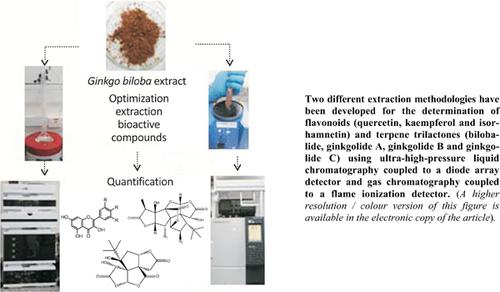Current Analytical Chemistry ( IF 1.7 ) Pub Date : 2020-10-31 , DOI: 10.2174/1573411015666191010124224 Alessandra von Ahn 1 , João Henrique Z. dos Santos 1

|
Background: The official compendium of the quantification of ginkgo flavonoids from Ginkgo biloba extract has been proposed using HPLC. The drawbacks of this technique appear to be due to the restricted efficiency in terms of the recovery results and suitability of the system for the quantification of these compounds. This study investigated the potential advantages and limitations of the development of efficient extraction methods for the recovery of flavonol glycosides (quercetin, kaempferol and isorhamnetin) and terpene trilactones (bilobalide, ginkgolide A, ginkgolide B and ginkgolide C) using extraction, quantification and detection techniques, namely, GC-FID and UHPLC-DAD, which are alternatives to those techniques available in the literature.
Methods: Two different extraction methodologies have been developed for the determination of flavonoids (quercetin, kaempferol and isorhamnetin) and terpene trilactones (bilobalide, ginkgolide A, ginkgolide B and ginkgolide C) using ultra-high-pressure liquid chromatography coupled to a diode array detector and gas chromatography coupled to a flame ionization detector.
Results: In this study, the Ginkgo biloba extract mass, hydrolysis preparation method (with or without reflux), and volume of the extraction solution seemed to affect the ginkgo flavonoid recovery. The UHPLC-based method exhibited higher extraction efficiency for ginkgo flavonoid quantification compared to the pharmacopoeial method. The developed method exhibited higher extraction efficiency for terpene quantification compared to the previous method that used extractive solution without pH adjustment, with less time of extraction and less amount of the sample and organic solvent aliquots.
Conclusion: The UHPLC and GC analysis methods established in this study are both effective and efficient. These methods may improve the quality control procedures for ginkgo extract and commercial products available in today´s natural health product market. The results indicate that redeveloped extraction methods can be a viable alternative to traditional extraction methods.
中文翻译:

从银杏提取的生物活性化合物的GC-FID和UHPLC-DAD定量评估
背景:已经提出了使用高效液相色谱法从银杏叶提取物中定量银杏黄酮的官方纲要。该技术的缺点似乎是由于回收结果的效率有限以及系统对这些化合物进行定量分析的适用性所致。这项研究调查了使用提取,定量和检测技术开发有效的提取方法以回收黄酮醇苷(槲皮素,山奈酚和异鼠李素)和萜烯三内酯(bilobalide,银杏内酯A,银杏内酯B和银杏内酯C)的潜在优势和局限性,即GC-FID和UHPLC-DAD,它们是文献中提供的那些技术的替代方法。
方法:已开发了两种不同的提取方法,采用超高压液相色谱-二极管阵列检测器测定类黄酮(槲皮素,山奈酚和异鼠李素)和萜烯三内酯(双酚内酯,银杏内酯A,银杏内酯B和银杏内酯C)气相色谱仪与火焰电离检测器相连。
结果:在本研究中,银杏叶提取物的质量,水解制备方法(有无回流)和提取液的体积似乎影响了银杏黄酮的回收率。与药典方法相比,基于UHPLC的方法显示出更高的银杏黄酮定量提取效率。与以前的方法相比,开发的方法显示出更高的萜烯定量提取效率,前一种方法使用的萃取溶液无需调节pH值,萃取时间更少,样品和有机溶剂等分试样的量也更少。
结论:本研究建立的UHPLC和GC分析方法既有效又高效。这些方法可能会改善当今天然保健产品市场上可获得的银杏提取物和商业产品的质量控制程序。结果表明,重新开发的提取方法可以替代传统提取方法。











































 京公网安备 11010802027423号
京公网安备 11010802027423号